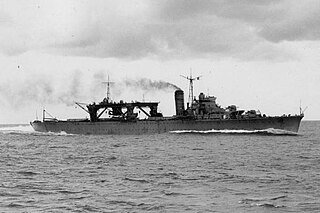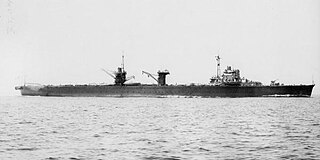
A cruiser is a type of warship. Modern cruisers are generally the largest ships in a fleet after aircraft carriers and amphibious assault ships, and can usually perform several roles.
Ten ships of the Royal Navy have been named HMS Hermes, after Hermes, the messenger god of Greek mythology, while another was planned:

The naval Battle of the Eastern Solomons took place on 24–25 August 1942, and was the third carrier battle of the Pacific campaign of World War II and the second major engagement fought between the United States Navy and the Imperial Japanese Navy during the Guadalcanal campaign. As at the Battle of the Coral Sea and the Battle of Midway, the ships of the two adversaries were never within sight of each other. Instead, all attacks were carried out by carrier-based or land-based aircraft.

A seaplane tender is a boat or ship that supports the operation of seaplanes. Some of these vessels, the seaplane carriers, could not only carry seaplanes but also provided all the facilities needed for their operation; these ships are regarded by some as the first aircraft carriers and appeared just before the First World War.

A light aircraft carrier, or light fleet carrier, is an aircraft carrier that is smaller than the standard carriers of a navy. The precise definition of the type varies by country; light carriers typically have a complement of aircraft only one-half to two-thirds the size of a full-sized fleet carrier. A light carrier was similar in concept to an escort carrier in most respects, however light carriers were intended for higher speeds to be deployed alongside fleet carriers, while escort carriers usually defended convoys and provided air support during amphibious operations.
Chitose (千歳) is a common first name in Japan and may refer to:
Tone (利根) was the lead ship in the two-vessel Tone class of heavy cruisers in the Imperial Japanese Navy. The ship was named after the Tone River, in the Kantō region of Japan and was completed on 20 November 1938 at Mitsubishi's Nagasaki shipyards. Tone was designed for long-range scouting missions and had a large seaplane capacity. She was extensively employed during World War II usually providing scouting services to their aircraft carrier task forces. She almost always operated in this capacity in conjunction with her sister ship Chikuma.
Chiyoda (千代田) is Japanese for "field of a thousand generations", and may refer to:

Chitose (千歳) was a light aircraft carrier of the Imperial Japanese Navy during World War II. First laid down as a seaplane tender in 1934 at Kure Navy yard, the ship originally carried Kawanishi E7K Type 94 "Alf" and Nakajima E8N Type 95 "Dave" floatplanes. Although it has been speculated that Chitose also carried Type A midget submarines, only her sister ship, Chiyoda had that capability. Chitose saw several naval actions, taking part in the Battle of Midway though seeing no combat there. She was bombed by B-17 Flying Fortresses off Davao, Philippines, on 4 January 1942, sustaining negligible damage. She covered the Japanese landings in the East Indies and New Guinea from January–April 1942, and was damaged in the Eastern Solomons in August 1942.

Chiyoda was a light aircraft carrier of the Imperial Japanese Navy during World War II. Originally constructed as the second vessel of the Chitose-class seaplane tenders in 1934, she continued to operate in that capacity during the Second Sino-Japanese War and the early stages of the Pacific War until her conversion into a light aircraft carrier after the Battle of Midway. She was sunk during the Battle of Leyte Gulf by a combination of naval bombers, cruiser shellfire and destroyer-launched torpedoes.
Ibuki may refer to one of the following ships of the Imperial Japanese Navy named after Mount Ibuki:

Nisshin (日進) was a seaplane tender (AV) of the Imperial Japanese Navy during World War II.

Mizuho was a seaplane carrier of the Imperial Japanese Navy during World War II. The ship was built at Kawasaki Shipbuilding at Kobe, Japan, and was completed in February 1939.

The Chitose-class aircraft carriers were a class of two seaplane tenders, later converted to light aircraft carriers, of the Imperial Japanese Navy during World War II. Under the terms of the Washington Naval Treaty, the total tonnage of Japan's naval vessels was limited by class. The Chitose-class ships were built as seaplane tenders, designed to make the conversion to aircraft carriers relatively easy. They served as seaplane tenders during the early part of the Pacific War. After the Battle of Midway, they were converted into light aircraft carriers. Both ships participated in the Battle of the Philippine Sea and both were sunk in the Battle of Leyte Gulf.
Yaeyama may refer to one of several naval ships of Japan:
At least five ships in the Imperial Russian, Soviet or Russian Navies have been named Varyag after the Varangian people, the Viking ancestors of the Rus.
Five naval vessels of Japan have been named Chiyoda:
At least two warships of Japan have borne the name Aso:
At least two warships of Japan have borne the name Kasagi:
This page is based on this
Wikipedia article Text is available under the
CC BY-SA 4.0 license; additional terms may apply.
Images, videos and audio are available under their respective licenses.








